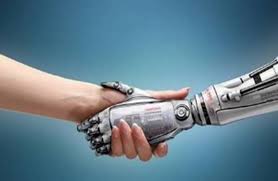Whereas many companies and organisations are busy with integrating features of Industry 4.0, Industry 5.0 is ready to make its first move. Industry 4.0 is a term that was introduced nine years ago in 2011 (Luenendonk, 2011). However, the adoption of the features of Industry 4.0 is still in its early stages when it comes to the use of, for example, Artificial Intelligence and the Internet of Things. So, are we yet ready for Industry 5.0?
For the ones who never heard of the terms Industry 4.0 and Industry 5.0, these terms refer to the former and next industrial revolutions. The first industrial revolution began with the introduction of steam engines, where craft workplaces were partly replaced by industrial fabrics. The discovery of new energy sources like electricity and petroleum and the introduction of the assembly line by Henry Ford was the cause of the second industrial revolution. The third revolution was between 1960 en 2000 and characterised by informatisation due to use of computers. People could manage machines behind their desk instead of physically serving the machine (Pouspourika, 2019).
Artificial Intelligence, machine learning, smart systems and big data drives companies to transform digitally. This is the key aspect of the fourth revolution, Industry 4.0. The technologies around Industry 4.0 make companies able to operate more efficiently, more data-driven and serve customers better. Moreover, digital transformation can increase revenue and EBIT by 22% and 19% respectively (Deloitte, 2020). As stated above, Industry 4.0 was first mentioned in 2011. Currently, many strategy consulting agencies help companies to transform digitally. Next to that, as students, we are making assignments based on the implementation of features of Industry 4.0. However, Industry 5.0 is in is ready to make its first move.
Where the focus of Industry 4.0 is on autonomous working systems, the focus of Industry 5.0, the fifth industrial revolution, is on the collaboration of humans and robots, and smart machines (James, 2020). Creating the interaction between human intelligence and autonomous systems seems very interesting since robots and systems miss the emotional capabilities humans have. Optimally utilize this collaboration could give companies a competitive advantage to companies who are still in the phase of Industry 4.0.
I am curious about your thoughts on this. Can companies start with implementing the fundaments of Industry 5.0, while they not fully integrated and utilised the features of Industry 4.0? And do you see the potential competitive advantage of the focus of Industry 5.0?
References:
Deloitte, 2020. Swim, not just float. Driving innovation and new business model through Industry 4.0. [Online]
Available at: https://www2.deloitte.com/content/dam/Deloitte/nl/Documents/energy-resources/deloitte-nl-driving-innovation-and-new-business-models-through-Industry40.pdf
[Accessed 7 October 2020].
Jardine, J., 2020. Industry 5.0: Top 3 Things You Need to Know. [Online]
Available at: https://www.mastercontrol.com/gxp-lifeline/3-things-you-need-to-know-about-industry-5.0/
[Accessed 7 October 2020].
Luenendonk, M., 2019. Industry 4.0: Definition, Design Principles, Challenges, and the Future of Employment`. [Online]
Available at: https://www.cleverism.com/industry-4-0/
[Accessed 7 October 2020].
Pouspourika, K., 2019. The 4 Industrial Revolutions. [Online]
Available at: https://ied.eu/project-updates/the-4-industrial-revolutions/
[Accessed 7 October 2020].

